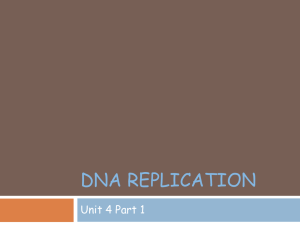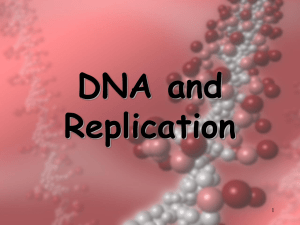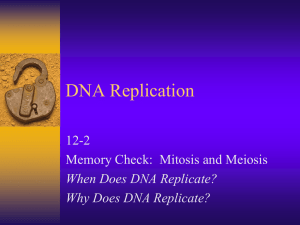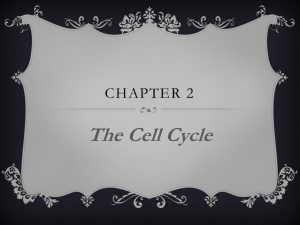DNA: Hereditary Molecules of Life
advertisement
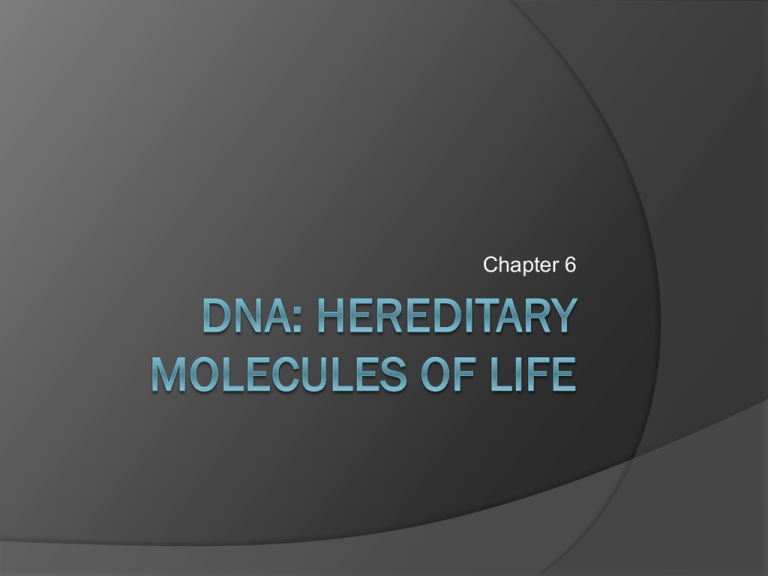
Chapter 6 Consists of Deoxyribose sugar Phosphate group A, T, C, G Double stranded molecule (Double Helix) Two strands of DNA run antiparallel to each other (opposite direction) 5’ to 3’ 5’ is the end with the phosphate group 3’ is where deoxyribose sugar is located Nitrogenous bases Held together by hydrogen bonds A pairs with T ( forms double bond) C pairs with G (forms a triple bond) DNA Four Requirements for DNA to be Genetic Material Must carry information Cracking the genetic code Must replicate DNA replication Must allow for information to change Mutation Must govern the expression of the phenotype Gene function DNA Replication Process of duplication of the entire genome prior to cell division S Biological significance extreme accuracy of DNA replication is necessary in order to preserve the integrity of the genome in successive generations In eukaryotes , replication only occurs during the S phase of the cell cycle. phase G1 interphase Mitosis -prophase -metaphase -anaphase -telophase G2 Basic rules of replication A. B. C. D. E. Semi-conservative Starts at the ‘origin’ Synthesis always in the 5-3’ direction Semi-discontinuous RNA primers required Mechanism of DNA Replication Step 1: Strand Separation Proteins bind to DNA and open up double helix Prepare DNA for complementary base pairing Step 2: Building Complementary Strands Proteins connect the correct sequences of nucleotides into a continuous new strand of DNA Step 3: Dealing With Errors during DNA Replication Proteins release the replication complex DNA Replication is Semi-Conservative Separating the two parent strands and building new complementary strand for each New DNA has one new strand and one old strand Strand Separation Double Helix Unwound at replication origins (many origins on DNA) Enzyme called helicase binds to origins and unwinds the two strands creating replication bubbles Two strands separating creates a replication fork Strand Separation Unwinding DNA creates tension Enzymes called topoisomerases relieves tension by cutting strands near the replication fork (supercoil) Single strands want to join back together Prevented by single-strand binding proteins (SSBs) by attaching to the DNA strands stabilizing them Topoisomerase Enzyme DNA Enzyme Strand Separation Multiple replication origins decrease the overall time of DNA replication to about 1 hour Building Complementary Strands DNA polymerase III Adds nucleotides to the 3’ end of a strand New strands are always assembled 5’ to 3’ Builds new strand using nucleoside triphosphates Building Complementary Strands RNA primase begins the replication process Builds small complementary RNA segments on strand at beginning of replication fork RNA primers DNA polymerase III can start to add nucleotides Building Complementary Strands Leading Strand DNA that is copied in the direction toward the replication fork Lagging Strand DNA that is copied in the direction away from the replication fork Leading and Lagging Strands 3 5 5 3 DNA polymerase III leading strand 5 3 3 5 3 5 5 5 3 lagging strand 3 5 3 5 lagging strand 5 5 leading strand growing replication fork 5 3 growing replication fork leading strand 3 lagging strand 5 5 5 5 3 Building Complementary Strands Anti parallel strands replicated simultaneously Leading strand synthesis continuously in 5’– 3’ Lagging strand synthesis in fragments in 5’-3’ Leading Strand Single primer is used to start strand DNA polymerase III moves towards replication fork 5’ to 3’ direction Continuous Lagging Strand DNA polymerase III moves away from replication fork Discontinuous Okazaki fragments are used to solve problem 1000 – 2000 base pairs long Multiple primers are used Lagging Strand DNA polymerase I removes RNA primers and replaces with DNA nucleotide Fills the gaps Building Complementary Strands DNA ligase Links last nucleotide to Okazaki fragment Formation of phosphodiester bond Dealing With Errors DNA polymerase Proofread and correct errors Errors are usually base pair mismatches After replication Average of 1 error per million base pairs DNA polymerase II Repairs damage after strands have been synthesized Chromosome Erosion DNA polymerases can only add to 3 end of an existing DNA strand DNA polymerase I 5 3 3 5 5 growing 3 replication fork DNA polymerase III 5 Loss of bases at 5 ends in every replication DNA polymerase I cannot replace final RNA primer 3 Does it Create a Problem? Telomeres Repeating, non-coding sequences at the end of chromosomes = protective cap limit to ~50 cell divisions 5 3 3 5 5 growing 3 replication fork telomerase 5 enzyme extends telomeres can add DNA bases at 5 end different level of activity in different cells high in stem cells & cancers -- Why? TTAAGGG TTAAGGG 3 Cells Aging Process Cell senescence Cells loses ability to function properly as a person ages Decrease in telomeres with age No longer provide protection for the chromosome Known as the Hayflick limit Possibly links to agerelated diseases Dementia, atherosclerosis, macular degeneration Packing of Eukaryotic DNA Organization Negative DNA wraps around positive histones Nucleosome – cluster of 8 histones Solenoids – coiled strings of nucleosomes (chromatin fibres) Prokaryotic DNA Organization Eubacteria/Archaea DNA One chromosome – circular in shape Unbound by a nuclear membrane Genetic Variation Among Bacteria Plasmids Smaller circular pieces of DNA that float throughout cell Conjugation Plasmids are able to exit one cell and enter another (when two bacteria are close) Useful in genetic engineering

